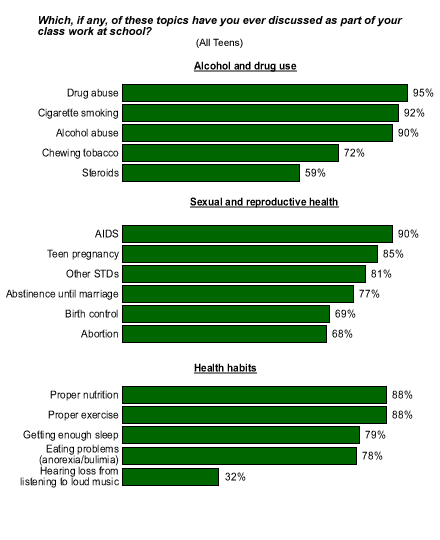In a time of significant education reform, public school curricula are being considered and reconsidered for the degree of positive impact they will have on students' adult lives. All this consideration may affect the amount of time and resources directed to subjects such as history, social studies -- and health education.
Middle school and high school health education teachers are like lifeguards. Each school year, they throw lifelines of education to teens, hoping they will latch on, survive the perils and pitfalls of their teen years, and carry what they've learned into healthy adulthood. Results from a Gallup Youth Survey* conducted last year indicate that teens at least recognize those lifelines are there, whether or not they are grabbing hold.
American teens (aged 13 to 17) were asked if they had ever discussed 16 health-related topics as part of their class work at school. With two exceptions, girls were just as likely as boys to say they discussed health topics that ranged from drug abuse and sexually transmitted diseases (STDs) to steroids and birth control. Interestingly, regardless of age, sex, academic standing, socio-economic status, religion or other demographic factors, there were few differences among teens' responses to each health-related topic, indicating that U.S. teens seem to receive similar health messages with similar levels of emphasis.

Alcohol and Drug Use
Ninety-five percent of teens said they had discussed drug abuse at school, and roughly nine in 10 said they had discussed cigarette smoking and alcohol abuse. The percentages dropped for two other substance-related topics: 72% reported discussing chewing tobacco and 59% said they had discussed steroids.
Teens seem to be receiving the anti-drug message, but are they just saying no? Results from the Centers for Disease Control and Prevention 2001 Youth Risk Behavior survey indicate that 29% of high school students currently smoke cigarettes, down from 36% in 1997 and 35% percent in 1999. Alcohol and illicit drug use percentages have remained mostly stable, according to 2001 National Institute on Drug Abuse figures, but steroid use is up among high school seniors.
Sexual and Reproductive Health
Abstinence, HIV/AIDS, STDs and the basics of reproduction figure prominently in most sex ed curricula, according to a 2000 Kaiser Family Foundation study on sex education in the United States. Students and teachers in the Kaiser study indicated that birth control and abortion did not figure as prominently as HIV/AIDS, reproduction basics and abstinence in the message of their most recent sex education course.
Teens' responses to the Gallup survey seem to mirror this curriculum emphasis. Nine in 10 teens reported discussing AIDS at school, and 81% reported discussing other sexually transmitted diseases such as syphilis or gonorrhea. Eighty-five percent of teens said they discussed teen pregnancy; there was a slight difference between the percentages of boys (80%) and girls (89%) who reported discussing this topic. Seventy-seven percent had discussed abstinence, 69% had discussed birth control, and 68% had discussed abortion.
Teens seem to be absorbing some of these messages, whether they are receiving them at school, home, or elsewhere. Teen birth rates in the United States declined 22% between 1991 and 2000, according to CDC figures. Sexual experiences (defined as having had sexual intercourse) among high school students declined 16% from 1991 to 2001, and condom use increased. Despite these improvements, the CDC estimates that approximately 3 million cases of STDs occur among teen-agers every year.
Health Basics
Eating right and getting enough exercise are tenets of good health, yet recent data on obesity among Americans suggest that teens and adults alike continue to struggle to adhere to them. But lack of education may not be as strong a factor in that problem as one might think: 88% of teens reported discussing proper nutrition at school and an equal percentage discussed proper exercise. Seventy-eight percent said they discussed eating problems such as anorexia or bulimia; girls (86%) were significantly more likely than boys (70%) to report discussing this topic.
Key Points
Teachers and schools are vital parts of the multi-faceted approach required to foster healthy habits among teens. Parents, peers, and others also share responsibility for shaping teen attitudes and health behaviors. Although it is difficult to pinpoint whether declines or improvements in risky behavior in the last decade result from parent, teacher, or peer influence, the broad observations are encouraging -- teens seem to retain the basic, consistent messages of health education.
*Findings are based on interviews with 501 American teens, aged 13 to 17, conducted from March through May 2001. For results based on this sample, one can say with 95% confidence that the maximum error attributable to sampling and other random effects is ±5%.